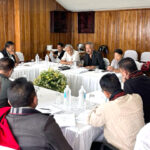The initiative launched by the Department of Women Resource Development, Government of Nagaland, and the ‘Look Up’ exhibition at the Highland Institute in Kohima highlight the critical importance of preserving Naga culture in an age dominated by globalization and rapid commercialization. Both events underscore the urgency of safeguarding the unique cultural heritage that defines Naga identity while promoting community engagement and awareness.
The consultative meeting held on October 4, aimed at launching the ‘Protection and Promotion of Tribal Designs’ project for 2024-25, is timely and much appreciated. This project is essential, as it seeks to elevate the status of traditional Naga attires and accessories that have gained popularity but have not significantly benefited indigenous artisans. As stated by Minister Salhoutuonuo Kruse, Naga tribal designs carry centuries of tradition and identity, functioning as vital storytellers of our ancestry. Protecting these designs ensures that they remain authentic and meaningful, especially for future generations who might otherwise lose touch with their roots.
It is a disheartening fact that most of the ‘traditional’ finery we adorn during festivals like Moatsü is now made by non-Nagas. Even our ethnic outfits, which feature traditional motifs, are mass-produced by non-Nagas. We have often encountered non-Nagas capitalizing on our traditional costumes on social media, yet there is hardly anything we can do about it. It is reported that the Watsü Mungdang is in the process of applying for GI registration for some of our traditional items, which is much appreciated. However, there is a need for institutionalizing the preservation of our cultural items, and the Department of Women Resource Development’s initiative seems to be moving in the right direction. While most government-led programs fail in Nagaland, it is hoped that this initiative will become a success story.
Conversely, the ‘Look Up’ exhibition connects Naga culture with the natural world, showcasing indigenous astronomy and its relationship with Naga biodiversity and folklore. This exhibition has attracted considerable attention, revealing how traditional narratives shape the understanding of constellations and environmental interactions. It serves as a reminder of the wisdom embedded in our cultural practices and the significance of conserving our natural heritage. Such exhibitions foster a sense of pride in our identity and encourage younger generations to appreciate and embrace their culture.
However, more venues and opportunities for cultural expression are needed in Nagaland, particularly in places like Mokokchung. Hosting events like the ‘Look Up’ exhibition in Mokokchung would not only celebrate local traditions but also create a platform for dialogue about environmental conservation and cultural preservation. By organizing such initiatives in Mokokchung, we can empower local communities and ensure that the richness of Naga culture is not confined to a single locale.
Preserving Naga culture is not merely an act of nostalgia; it is vital for maintaining our identity and ensuring sustainable development. As we look towards the future, we must support initiatives that celebrate our heritage and promote community involvement in preserving the essence of our traditions, which is sorely missed in Mokokchung.



